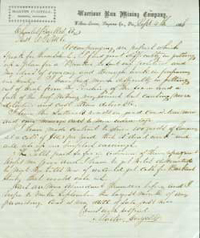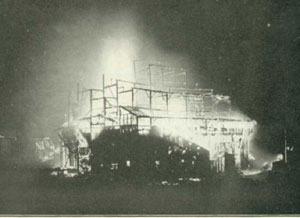Three years and two days after the writing of Coryell's letter (See right column), there occurred one of the worst disasters in mining history just across the valley from Warrior Run. This was the Avondale Mine Disaster, the site of which is along the old Lackawanna right-of-way near where Route 29 meets Route 11.
It was a typical Industrial Revolution atrocity that came about due to no regard for the safety of the workers. The mine shaft was the only exit and vent from the mine. Directly over the shaft had been built the wooden, flammable breaker building. At the bottom of the shaft, a fire was maintained to create an updraft. That is how they ventilated the mines. You guessed it. The fire got loose, went up the shaft and set the breaker ablaze, blocking off the only exit from the mine. All the oxygen got sucked up by the fire and the deadly gas methane took over. It could kill instantly as it did the first two rescuers to descend the shaft. 110 miners were found dead at the bottom. They were mostly Welsh. This happened on September 6, 1869.
Following the disaster, the State of Pennsylvania passed laws mandating at least two exits from mines and prohibiting the building of breakers over shafts. The use of ventilation by fans became commonplace.
Miners' Songs
There was a sad and pretty song written about the Avondale disaster. The miners had plenty of songs, a number of them, like Civil War songs, written to old tunes brought over from Ireland. Anyone familiar with Irish folk music has heard some of these tunes. Several decades ago, a fellow named Charles Korson went around PA collecting miners' songs on paper and record. The result was a book entitled Minstrels of The Mine Patch and a collection of recordings for the Library of Congress, Songs and Ballads of the Anthracite Miners.
One of my favorite songs is about Reilly who couldn't read No Smoking signs and lit up his pipe in the powder works:
Up went Reilly
far above the town!
And men that travel like Reilly did
are seldom ever found.
Then there's this one from John L. Lewis days:
I t'ink I sing a little song
Hope I ain't sain' nuthin' wrong!
Hope this fills you up with cheer
just like twot'ree shots a beer!
Union man, union man,
he must have full dinner can!
A-F-L-C-I-O,
callin' "Strike!"
Out we go!
And finally here's one called The Sugar Notch Entombment. I never heard this, don't know the tune of it and don't see how it even fits a tune, but there's a lot of stretching in folk music. It's about trapped miners forced to eat their mule. You may want to skip the fourth verse. It would be interesting to learn if the guys in the song were real people.
It was in the month of April in eighteen seventy-nine
When seven men came to Sugar Notch to work down in the mine.
The night shift was before them and honest they began
The driver came and told them that the mine was caving in.
They walked in the gangway and then sat down,
They held a consultation and the talk went all around;
Pricey held the safety lamp and Reilly he was last,
Hawkins put up his hand and shut off all the gas.
The rocks stood on their edges up against the roof,
And all of them sat quiet, afraid for to make a move.
Some were very hungry and some were very weak;
Says Johnny Green, "Let's kill the mule and have a jolly feast."
So Bill Kinney went and got his mule and tied him to a prop,
The tears came rolling down his cheeks saying, "Harry, you must drop."
On picking up the hammer, Johnny Green found it to be dull,
He hit the poor old mule ten times on the head before he cracked his skull.
Then Kinney said, "Harry, you're dead and gone; your life is gone astray,
But many a hundred cars of coal you've pulled out of this gangway,
Many a driver's drove you, but now your driving's at an end."
They hauled him in and shared him fair between the seven men.
From Minstrels of the Mine Patch, Korson
More Things in Heaven, Earth and under the Earth: A Mine Ghost Story
Back around 1962, a few miners became trapped in a mine near Sheppton, PA, a few miles west of Hazleton. Their plight attracted national media attention. As they waited in the dim, dying lamp light, wondering if they'd ever be rescued, these miners spotted figures moving through the mine tunnels. They appeared to be other miners. Thinking they were fellow cave-in prisoners or even rescuers, the trapped miners called out to these other men each time one passed by. But no answer was returned. In fact these silent visitors were seen disappearing into the tunnel walls. Then after several days, the miners saw a vision of Pope John XXIII. He appeared to be giving them a blessing and it was then that they knew they would be all right. They were rescued. They agreed among themselves not to tell the media or otherwise broadcast their supernatural experience. Nevertheless the story did get around the little towns in that corner of Schuylkill County andwas told to me by an old Oneida man.
 |
| Mining in the 1860s: A Letter to the President of the Warriour Run Mining Co. Warrior Run, a town and a creek ("run" ="creek"), are located next to Sugar Notch. Here is the text of an 1866 letter from Martin Coryell to Charles Bartels concerning a mining operation in that area. Bartels is a Wyoming Valley name associated with brewing. Martin Coryell was a somebody, too. He was a mining engineer whose resumee can be found on the internet. The Warriour Run Mining Company did not last long after this letter's composition. By 1873, most of the land and mining property around Sugar Notch was owned by the Lackawanna Railroad. The trend was always toward monopoly. Typical of the time, one big company acquired the mines, the breakers and the transportation. To: Charles Bartels, Esq. Sept, 4th, 1866 Accompanying are papers which speak for themselves. I find great difficulty in getting up a plan for a breaker to suit our position and my ideal of economy and thorough work in preparing our coal. I have had much difficulty in getting out of coal from the pinching of the seam and a fall of the roof. Nothing very serious but causing more detention and cost than desirable. I have the lateral roads in good condition now and can manage cars to more advantage. I have made contract to drive 100 yards of gangway at a cost of $10.00 per yard. This is "dead work" and will use up our surplus earnings. The tolls paid so far in advance of their repayment keeps me poor and I have to get notes discounted to meet the tolls. Now if we could get cash for Barkus stock, that would ease us. Cars are more abundant now than ever before and I hope to make September the largest month of any preceding. Coal is very dull of sale just now. Yours with Respect, Martin Coryell |
 |
| A burning breaker at night. |